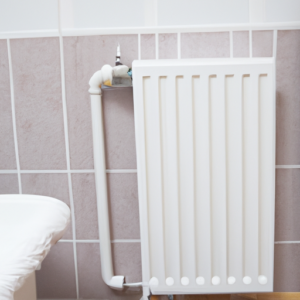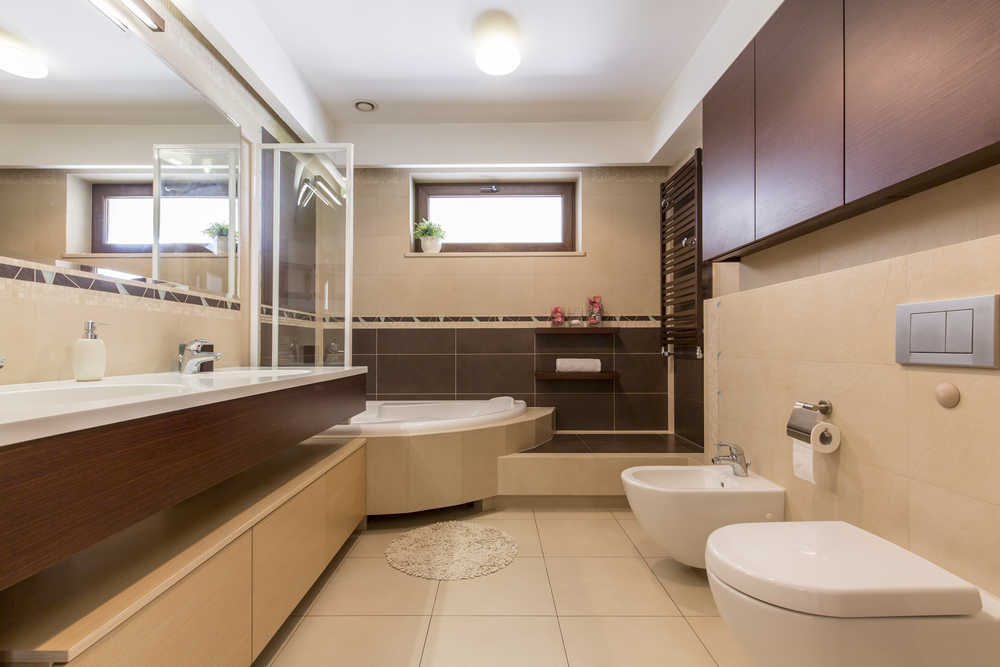Last Updated on February 16, 2023
Are you looking for the best type of heater to keep your bathroom warm? You may have heard about electric, gas and radiant heaters but which one is really best for bathrooms? In this blog post, we’ll explore the pros and cons of each type of heater so that you can decide what kind works best in your home. Weighing up these three options will help ensure that when it comes to finding out what type of heater is best for bathrooms, you make an informed decision!
Table of Contents:
- Electric Heaters: Pros and Cons
- Gas Heaters: Pros and Cons
- Radiant Heaters: Pros and Cons
- Choosing the Right Type for Your Bathroom
- FAQs in Relation to What Type of Heater is Best for Bathrooms
- Keep Your Bathroom Warm
Electric Heaters: Pros and Cons
Electric heaters are a popular choice for bathrooms due to their energy efficiency, cost-effectiveness, and safety. They provide a comfortable temperature without taking up too much space or using too much electricity.
When it comes to energy efficiency, electric heaters are the way to go. They use less power than other types of heating systems, so they can save you money on your utility bills over time. Additionally, electric heaters don’t require any additional fuel sources like gas or oil, which makes them even more economical in the long run.
In terms of cost-effectiveness, electric heaters are an excellent option as well. The initial installation costs may be higher than those associated with other heating systems, but the long-term savings will make up for it quickly. Electric heaters also tend to last longer than other types of heating systems, so you won’t have to worry about replacing them anytime soon either.
Safety is another major advantage when it comes to electric heaters in bathrooms, as they don’t produce any open flames or combustible gases like some other types of heating systems do. This eliminates the risk of fire or carbon monoxide poisoning from these devices, making them ideal for families with small children and pets who might otherwise be at risk from traditional heating methods such as radiators and boilers.
Finally, installing an electric heater in your bathroom doesn’t require any special skills or tools – just plug it into a wall outlet, and you’re good to go. This makes them incredibly easy (and affordable) for anyone looking for an efficient way to keep their bathroom warm during cold winter months without having to invest in expensive equipment or hire professionals for installation services.
Electric heaters are a great option for those who want to quickly and efficiently heat their bathroom, but they can also be expensive. Now let’s look at the pros and cons of gas heaters.
Gas Heaters: Pros and Cons
They provide an efficient way to keep your bathroom warm without having to turn up the thermostat in other parts of the house.
Pros:
Energy Efficiency – Gas heaters use natural gas or propane as fuel sources which can be more efficient than electric models. This means you can save money on your heating bills while still keeping your bathroom comfortable.
Cost-Effectiveness – The initial installation costs of gas heaters may be higher than those of electric models, but they are usually cheaper to run in the long term since they require less electricity and don’t need regular maintenance as electric ones do.
Safety – Gas heaters are designed with safety features such as flame failure devices that shut off the heater if it detects a problem with the flame or if there is insufficient oxygen present in the room. This makes them much safer than traditional open fires or wood-burning stoves, which can pose a fire hazard when not properly maintained.
Cons:
Installation Requirements – Installing a gas heater requires specialised knowledge and tools, so it’s important to hire an experienced professional who knows how to safely install one in your home. It also needs access to an existing gas line, so you may have additional costs associated with running new pipes from outside into your bathroom if necessary.
Maintenance Costs – While they require less maintenance than electric models, regular servicing is still recommended for optimal performance and safety reasons which will incur additional costs over time depending on how often you use it and its age/condition etc.
Gas heaters are an affordable and efficient way to warm up a bathroom, but they can be dangerous if not installed correctly. Radiant heaters provide another option that is safer and more energy-efficient; let’s explore the pros and cons of radiant heaters in the next section.
Radiant Heaters: Pros and Cons

Radiant heaters are a popular choice for bathrooms, as they provide an efficient and cost-effective way to keep the room warm. But before you invest in one, it’s important to understand the pros and cons of radiant heating systems.
Energy Efficiency: Radiant heaters are highly energy efficient because they only heat up when needed. They also don’t waste energy by heating up large areas, or unused spaces like other types of heating systems do. This makes them ideal for small bathrooms that need to be heated quickly and efficiently.
Cost: Radiant heaters tend to be more expensive than traditional radiators or convectional electric wall units, but their long-term savings make them worth considering if you’re looking for a cost-effective solution.
Safety: As with any type of heater, safety is paramount when using radiant heaters in your bathroom. Make sure that all electrical connections are properly insulated and that there’s no risk of water getting into contact with the heater itself – this could cause an electrical fire hazard. Additionally, ensure that any combustible materials, such as curtains or towels, are kept away from the unit at all times.
Installation Requirements: Installing a radiant heater can be tricky depending on where it needs to go in your bathroom – some models require professional installation due to their complexity while others may just need basic DIY skills (and tools). Be sure to read through the instructions carefully before attempting anything yourself.
Maintenance: Radiant heaters require minimal maintenance compared with other types of heating systems; however, regular cleaning is still recommended to ensure its efficiency over time. It’s also important to check regularly for signs of wear and tear, which could affect its performance – replacing parts promptly will help keep your system running smoothly throughout its lifespan.
Overall, radiant heaters offer a great solution for bathrooms as they provide fast and efficient heating. However, it is important to consider the pros and cons before making a decision. Now let’s take a look at our conclusion to determine which type of heater is best for your bathroom.
Choosing the Right Type for Your Bathroom
When it comes to choosing the right type of heater for your bathroom, there are a few key factors to consider. Electric heaters offer convenience and cost-effectiveness but may not be as powerful or efficient as gas or radiant heaters. Gas heaters provide more power and efficiency than electric models, but they require an additional installation process and can be expensive to operate. Radiant heaters are energy-efficient and provide consistent warmth; however, they take longer to warm up than other types of heating systems.
Electric Heaters: Pros – Electric heaters are relatively inexpensive compared to other types of heating systems, easy to install without any extra work required, and generally use less energy than gas or radiant models. Cons – They don’t produce as much power or warmth as gas or radiant options, so you may need multiple units in larger bathrooms; they also tend to be noisy when running at full capacity.
Radiant Heaters: Pros – Radiant heaters are energy-efficient and provide consistent warmth, as they don’t require a fan to circulate the air. They also take up less space than other types of heating systems. Cons – They can take longer to warm up than electric or gas models, so if you need immediate warmth in your bathroom, this may not be the best option; additionally, radiant heaters tend to be more expensive upfront compared to other options.
FAQs in Relation to What Type of Heater is Best for Bathrooms
What is the most efficient way to heat a bathroom?

Heating a bathroom efficiently depends on the size of the room and its insulation. Generally, electric radiators are considered to be one of the most efficient ways to heat a bathroom, as they can be thermostatically controlled and provide instant warmth. For larger bathrooms, an electric fan heater is also an option as it quickly warms up the air in the room but may not maintain temperature for long periods of time. Alternatively, underfloor heating systems are energy-efficient and require minimal maintenance once installed. Ultimately, it’s important to consider all options before making a decision so you can find what works best for your home and budget.
Is it good to have a heater in the bathroom?
Having a heater in the bathroom can be beneficial, depending on your individual needs. It can help to maintain a comfortable temperature and keep moisture levels low, which is important for preventing mould growth. Additionally, it can provide extra warmth during colder months or when taking a shower. However, you should ensure that any electrical appliances are installed correctly by an experienced professional to avoid potential hazards such as electric shocks or fires. Ultimately, if you feel like having a heater in the bathroom is necessary for your comfort and safety, then it could be worth considering.
What is the best way to heat a small bathroom?
The best way to heat a small bathroom depends on the size of the room, budget and desired temperature. Electric radiators are an efficient option for smaller bathrooms as they provide quick heating without taking up too much space. For larger rooms, convection or fan-assisted electric heaters may be more suitable. If you’re looking for a cost-effective solution, consider installing an underfloor heating system – it takes longer to warm up but can save money in the long run. Alternatively, if you want instant warmth with minimal fuss, opt for an infrared heater which is easy to install and maintain.
How can I heat my bathroom cheaply?
There are several ways to heat your bathroom cheaply. Firstly, you can install a low-cost electric radiator or fan heater. These are usually the most cost-effective and energy-efficient options for heating a small space like a bathroom. Secondly, you could opt for an infrared panel heater which is designed to warm up objects in the room rather than just the air. Finally, if you have access to natural gas, installing a combi boiler with radiators is another great way of keeping your bathroom warm without breaking the bank. Whichever method you choose, make sure it’s installed correctly by a qualified professional for maximum efficiency and safety.
Keep Your Bathroom Warm
Electric heaters provide convenience and safety but can be expensive to run. Gas heaters offer a cost-effective option but require ventilation. Radiant heaters provide efficient heating without taking up too much space, but they may not be suitable for larger bathrooms. Ultimately, the choice of which type of heater is best for bathrooms depends on your individual needs and preferences.
Paul is the type of person who never met a problem he couldn’t fix. He can always be found tinkering with something in his house, even if it isn’t broken! His tips and tricks are often shared on our site. He’s the one you call when something breaks because he has been known to improvise fixes for everything from leaky faucets to malfunctioning dryers.

